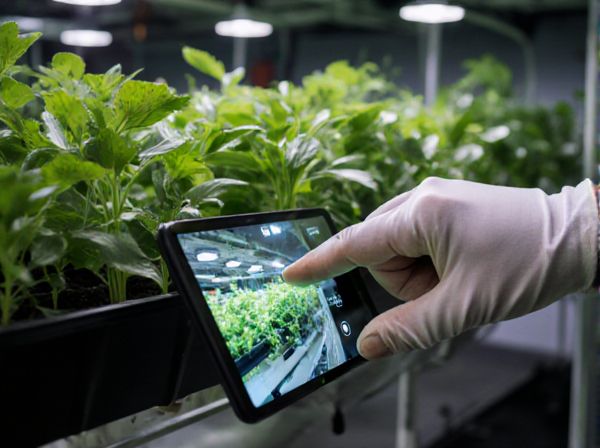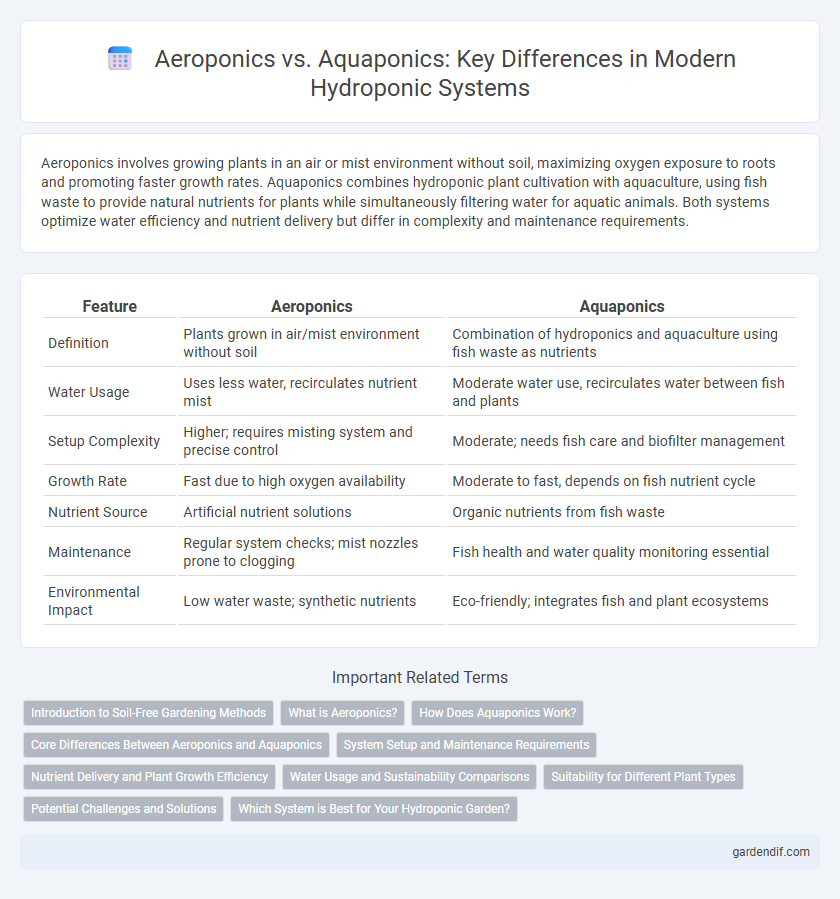
Aeroponics vs Aquaponics Illustration
Aeroponics involves growing plants in an air or mist environment without soil, maximizing oxygen exposure to roots and promoting faster growth rates. Aquaponics combines hydroponic plant cultivation with aquaculture, using fish waste to provide natural nutrients for plants while simultaneously filtering water for aquatic animals. Both systems optimize water efficiency and nutrient delivery but differ in complexity and maintenance requirements.
Table of Comparison
| Feature | Aeroponics | Aquaponics |
|---|---|---|
| Definition | Plants grown in air/mist environment without soil | Combination of hydroponics and aquaculture using fish waste as nutrients |
| Water Usage | Uses less water, recirculates nutrient mist | Moderate water use, recirculates water between fish and plants |
| Setup Complexity | Higher; requires misting system and precise control | Moderate; needs fish care and biofilter management |
| Growth Rate | Fast due to high oxygen availability | Moderate to fast, depends on fish nutrient cycle |
| Nutrient Source | Artificial nutrient solutions | Organic nutrients from fish waste |
| Maintenance | Regular system checks; mist nozzles prone to clogging | Fish health and water quality monitoring essential |
| Environmental Impact | Low water waste; synthetic nutrients | Eco-friendly; integrates fish and plant ecosystems |
Introduction to Soil-Free Gardening Methods
Aeroponics uses mist to deliver nutrients directly to plant roots suspended in air, maximizing oxygen exposure for accelerated growth. Aquaponics combines fish farming with hydroponic plant cultivation, creating a symbiotic environment where fish waste provides natural nutrients for plants. Both methods eliminate soil, enhancing resource efficiency and reducing environmental impact in sustainable agriculture.
What is Aeroponics?
Aeroponics is a soil-free growing technique where plants are suspended in air and their roots are misted with a nutrient-rich solution, promoting efficient oxygen exposure and nutrient absorption. This method enables faster growth rates and uses up to 90% less water compared to traditional soil agriculture. Aeroponics contrasts with aquaponics by solely relying on nutrient sprays rather than integrating fish waste as a natural fertilizer source.
How Does Aquaponics Work?
Aquaponics combines aquaculture and hydroponics by using fish waste to provide essential nutrients for plant growth in a soil-free system. Fish produce ammonia, which beneficial bacteria convert into nitrates that plants absorb as fertilizer, improving water quality for the fish. This symbiotic cycle creates a sustainable and efficient ecosystem for growing crops and raising aquatic animals simultaneously.
Core Differences Between Aeroponics and Aquaponics
Aeroponics utilizes a misting system to deliver nutrient-rich water directly to plant roots suspended in air, enhancing oxygen availability and promoting faster growth. Aquaponics integrates aquaculture with hydroponics by circulating nutrient-laden water from fish tanks to plants, creating a symbiotic environment where fish waste serves as a natural fertilizer. The core difference lies in aeroponics' focus on air and mist nutrient delivery, while aquaponics combines aquatic animal farming with plant cultivation for dual production.
System Setup and Maintenance Requirements
Aeroponics systems require a network of misting nozzles and pumps to deliver nutrient-rich water directly to plant roots suspended in air, demanding precise control and regular cleaning to prevent clogs and system failure. Aquaponics combines hydroponics with aquaculture, necessitating a balanced ecosystem involving fish tanks, biofilters, and grow beds, which requires monitoring water quality parameters such as pH, ammonia, and nitrate levels to maintain both plant and fish health. Maintenance in aeroponics is more technology-intensive and prone to mechanical issues, whereas aquaponics requires ongoing biological management and water chemistry adjustments to sustain system stability.
Nutrient Delivery and Plant Growth Efficiency
Aeroponics delivers nutrients by misting oxygen-rich nutrient solutions directly onto plant roots, maximizing oxygen exposure and enhancing nutrient absorption rates, leading to faster plant growth and higher yields. Aquaponics combines hydroponics with aquaculture, using fish waste as a natural nutrient source, which supports sustainable nutrient recycling but may result in slower nutrient uptake compared to aeroponics. Aeroponic systems typically exhibit greater efficiency in nutrient delivery and accelerated plant growth due to precise control over root environment and oxygen availability.
Water Usage and Sustainability Comparisons
Aeroponics uses up to 90% less water than traditional farming by misting nutrient-rich water directly onto plant roots, making it highly efficient for water conservation. Aquaponics combines fish farming and hydroponics by recycling water between the fish tanks and plants, significantly reducing water waste while creating a sustainable ecosystem. Both systems offer water-saving benefits, but aeroponics requires less water input overall, whereas aquaponics enhances sustainability by integrating nutrient cycling and waste reduction.
Suitability for Different Plant Types
Aeroponics is highly suitable for growing leafy greens, herbs, and small fruiting plants due to its efficient oxygen delivery and precise nutrient misting. Aquaponics supports a broader range of crops including leafy greens, vegetables, and fruiting plants by combining fish farming with hydroponics, enhancing nutrient availability naturally. Each system's suitability depends on plant root sensitivity and nutrient requirements, making aeroponics ideal for fast-growing, delicate plants, while aquaponics excels in sustainable cultivation of diverse crops with integrated fish production.
Potential Challenges and Solutions
Aeroponics faces potential challenges such as root desiccation due to mist system failures and higher energy consumption for maintaining mist cycles, which can be mitigated by incorporating backup power systems and optimizing mist scheduling with sensors. Aquaponics encounters complex balancing issues between fish health and plant nutrient requirements, often addressed by continuous water quality monitoring and automated nutrient dosing systems. Both systems require specialized knowledge and initial setup costs, best managed through targeted training programs and phased implementation strategies to improve system efficiency and sustainability.
Which System is Best for Your Hydroponic Garden?
Aeroponics delivers oxygen-rich nutrient mist directly to plant roots, promoting rapid growth and efficient water use, making it ideal for small spaces and high-value crops. Aquaponics integrates fish farming with hydroponics, creating a symbiotic environment where fish waste fertilizes plants, reducing the need for synthetic nutrients and supporting sustainable food production. Choosing between aeroponics and aquaponics depends on factors like space, crop type, budget, and desired sustainability level for your hydroponic garden.
Aeroponics vs Aquaponics Infographic

 gardendif.com
gardendif.com